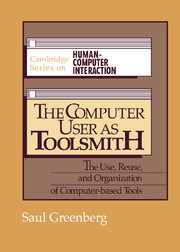Book contents
- Frontmatter
- Contents
- List of figures
- List of tables
- Foreword
- Acknowledgments and dedication
- 1 Introduction
- 2 Studying UNIX
- 3 Using commands in UNIX
- 4 Techniques for reusing activities
- 5 Recurrent systems
- 6 Reuse opportunities in UNIX csh – potential and actual
- 7 Principles, corroboration, and justification
- 8 Organizing activities through workspaces
- 9 A workspace system: description and issues
- 10 Conclusion
- Appendix A A sample trace
- Appendix B Summary statistics for each subject
- References
- Author index
- Subject index
1 - Introduction
Published online by Cambridge University Press: 26 May 2010
- Frontmatter
- Contents
- List of figures
- List of tables
- Foreword
- Acknowledgments and dedication
- 1 Introduction
- 2 Studying UNIX
- 3 Using commands in UNIX
- 4 Techniques for reusing activities
- 5 Recurrent systems
- 6 Reuse opportunities in UNIX csh – potential and actual
- 7 Principles, corroboration, and justification
- 8 Organizing activities through workspaces
- 9 A workspace system: description and issues
- 10 Conclusion
- Appendix A A sample trace
- Appendix B Summary statistics for each subject
- References
- Author index
- Subject index
Summary
There is nothing quite so frustrating for the avid do-it-yourselfer than to begin a project, suddenly need a particular tool, but have no idea where in the house to look for it.
— Practical Homeowner's 1987 Do-It-Yourself AnnualGeneral-purpose computer environments that furnish a large set of diverse tools are often hard to use. Although some difficulty is associated with using any particular tool, this book is concerned with the problems that a person faces when selecting a tool from the many available, reusing that tool while performing a task, and organizing the chosen tools in a way that makes them ready to hand later on. Surprisingly, methods and habits for using physical tools that have evolved over millions of years have not been transferred effectively to the computer domain.
The goal of the research discussed in this book is to identify properties of a human–computer interface that supports how people select, reuse, and organize the tools available in general-purpose computing environments. These properties come from empirical analyses of user behavior. This introduction sets the scene first by reviewing physical tools, from their very natural use by animals to ultra sophisticated machinery that taxes human capabilities beyond acceptable performance limits. Section 1.2 moves to the focus of this book – general-purpose computing environments that make diverse collections of on-line tools available. It identifies two problem areas: the dearth of knowledge about people's use of on-line tools, and the poor existing user support for everyday interactions with them.
- Type
- Chapter
- Information
- The Computer User as ToolsmithThe Use, Reuse and Organization of Computer-Based Tools, pp. 1 - 10Publisher: Cambridge University PressPrint publication year: 1993

